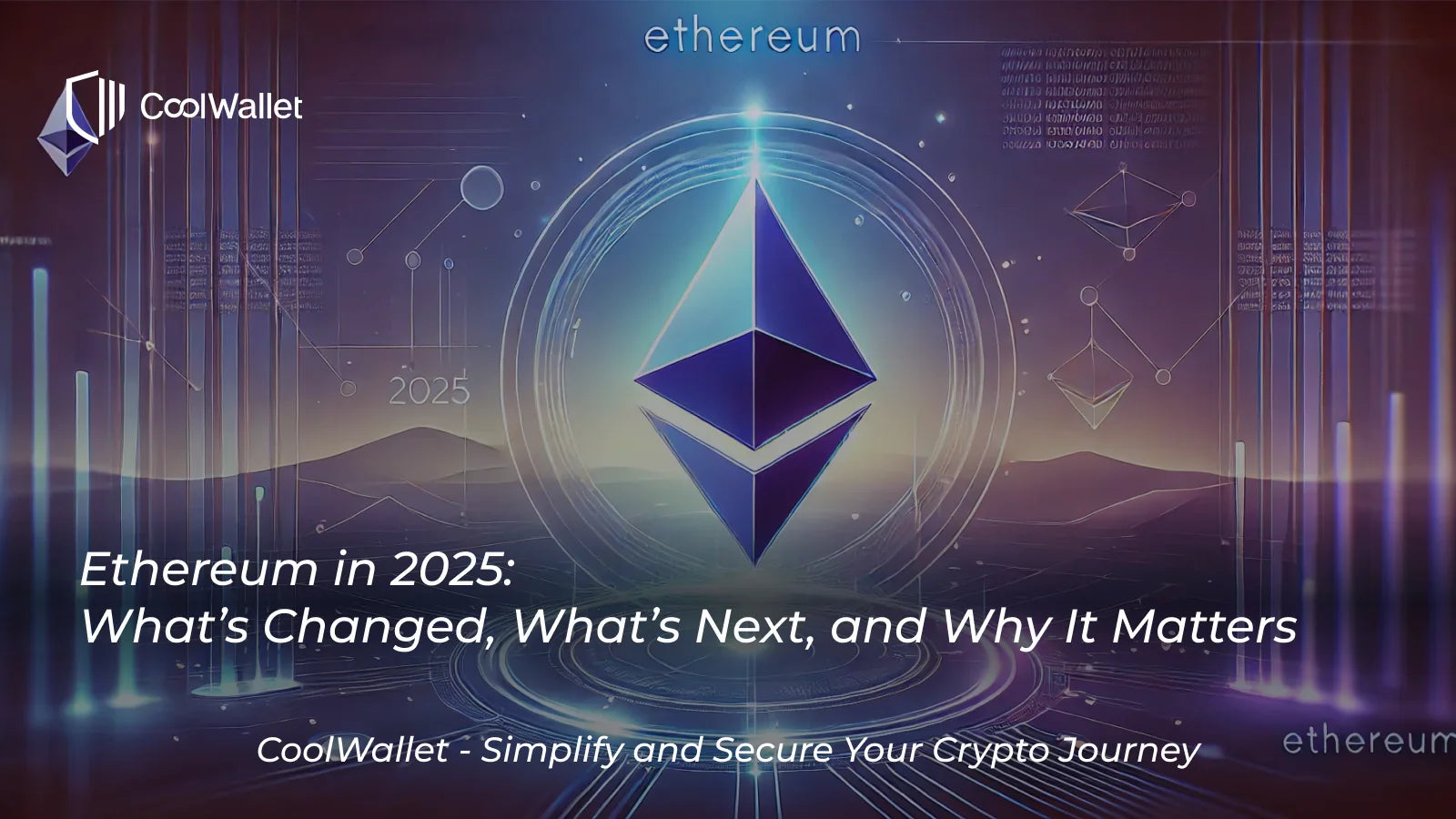Ethereum has come a long way since its launch in 2015. Originally known for introducing smart contracts and decentralised applications (DApps), it has grown into the backbone of Web3—powering everything from DeFi to NFTs and DAOs. But in 2025, Ethereum is entering a new phase—one shaped by technological upgrades, rising competition, regulatory shifts, and shifting market sentiment.
In this updated blog, we’ll walk you through what Ethereum is today, what’s changed since 2024, and what lies ahead.

Content
- What is Ethereum
- From Launch to Layer 2: A Brief Look Back
- The Pectra Upgrade: What It Means for Ethereum in 2025
- Price, Performance and Market Pressures
- Security and Ecosystem Health
- Vitalik Buterin on Ethereum’s Future
- Final Thoughts: Where Ethereum Stands in 2025
What is Ethereum
Ethereum is a decentralised blockchain network designed to support smart contracts—programs that run automatically when conditions are met. Unlike Bitcoin, which focuses on peer-to-peer payments and scarcity, Ethereum was built as a platform for developers to create decentralised applications (dApps).
ETH, Ethereum’s native token, is used to pay for transactions and services on the network, such as deploying smart contracts or interacting with dApps. It also plays a central role in staking, the consensus mechanism that secures the network.
From Launch to Layer 2: A Brief Look Back
Ethereum has undergone significant changes since its inception. The most important recent milestones include:
The Merge (2022)
In 2022, Ethereum completed "The Merge"—a transition from the energy-intensive Proof of Work system to Proof of Stake. This move drastically reduced Ethereum’s energy consumption by over 99% and paved the way for future scalability.
Shanghai Upgrade (2023)
This update enabled withdrawals of staked ETH for the first time, giving validators the flexibility to unlock their assets and creating a more dynamic staking environment.
Rise of Layer 2 Networks
With network congestion and high fees still a concern, Layer 2 networks like Arbitrum, Optimism, and Base became essential for scaling Ethereum. These solutions process transactions off-chain while still benefiting from Ethereum’s security.
The Pectra Upgrade: What It Means for Ethereum in 2025
Scheduled for 7th May 2025, the Pectra upgrade is Ethereum’s most significant network improvement since The Merge. Named after the combination of the Prague (execution layer) and Electra (consensus layer) upgrades, Pectra aims to enhance performance, flexibility, and user experience across the Ethereum ecosystem.
Key Features of Pectra
1. EIP-7251: Higher Staking Limits
Currently, Ethereum validators can only stake 32 ETH per validator node. With EIP-7251, this limit will be raised to 2,048 ETH, allowing large stakers to consolidate multiple validators. This reduces operational overhead and helps simplify the staking infrastructure—especially valuable for institutions and staking services.
2. Account Abstraction (EIP-3074 and/or EIP-4337-related work)
Pectra lays the groundwork for account abstraction, a feature that lets wallets function more like smart contracts. It enables users to batch transactions, sponsor fees, and recover accounts without seed phrases—ushering in a more user-friendly, app-like experience.
3. Paymaster Support (via account abstraction)
Through account abstraction, Pectra introduces Paymasters, which allow users to pay transaction fees in tokens other than ETH. This is a major usability upgrade for onboarding new users who may not hold ETH initially.
4. Enhanced Support for Layer 2 (via “blob” improvements)
Building on EIP-4844 (proto-danksharding from the Decun upgrade), Pectra expands Ethereum's capacity to handle rollup data efficiently. It allows Layer 2 networks to post more data at lower costs, improving scalability while reducing congestion on the mainnet.
5. Other UX Improvements and Maintenance Fixes
Pectra will also introduce smaller changes aimed at streamlining wallet interactions, improving gas efficiency, and addressing technical debt accumulated over previous upgrades.
Why Pectra Matters
Pectra isn't just a technical tune-up—it’s a foundational upgrade that pushes Ethereum closer to its long-term vision: a secure, scalable, and user-friendly platform for the next wave of Web3 adoption.
While some concerns have been raised about how Pectra might further empower Layer 2s (possibly at the expense of Ethereum Layer 1 revenue), its broader impact is overwhelmingly positive. By making the network more efficient, accessible, and easier to use, Pectra sets the stage for Ethereum to stay competitive as newer blockchains chase market share.
Price, Performance and Market Pressures
Ethereum's price performance has been underwhelming in early 2025. ETH is down over 45% year-to-date, trading near $1,800 in April. This decline has been driven by a mix of macroeconomic factors, regulatory concerns, and internal dynamics.
Standard Chartered recently revised its 2025 Ethereum price target from $10,000 to $4,000, warning of a “structural decline.” The concern is that Layer 2 networks like Coinbase’s Base, while improving scalability, are also siphoning off value that once flowed directly to Ethereum's Layer 1.
At the same time, Ethereum continues to face strong competition from alternative chains like Solana, Sui, and Avalanche—all of which offer faster transaction speeds and lower fees.
Security and Ecosystem Health
Security continues to be a top concern in the crypto space. In February 2025, crypto exchange Bybit suffered the largest Ethereum theft on record, with hackers draining over $1.5 billion in ETH due to a compromised wallet. While this incident wasn't caused by a flaw in the Ethereum protocol itself, it highlights the ongoing risks around custody and user protection—especially when large centralized platforms are involved.
(Looking to upgrade your own wallet security? Learn how CooWallet enhances it here.)
Despite these challenges, Ethereum remains the most active and developed blockchain by number of dApps, developer engagement, and enterprise adoption. The rise of tokenized real-world assets—like State Street’s collaboration with Taurus—continues to rely heavily on Ethereum’s infrastructure.
Vitalik Buterin on Ethereum’s Future
At ETHGlobal Taipei in early 2025, Ethereum co-founder Vitalik Buterin made it clear that Layer 1 still plays a vital role. He pointed out that while most activity is shifting to Layer 2, Ethereum’s core network must remain scalable and robust—for censorship resistance, cross-chain asset movement, and network coordination.
Final Thoughts: Where Ethereum Stands in 2025
Ethereum isn’t the same network it was in 2020—or even 2023. It’s bigger, more complex, and navigating a much more competitive and regulated space. The Pectra upgrade and the rapid evolution of Layer 2 show that Ethereum is still moving fast. But questions around its long-term value capture, fee structure, and user growth remain open.
One thing is certain: Ethereum has moved beyond experimentation. It’s now critical infrastructure for the decentralized world. And like any major system, its future depends on three things—stability, innovation, and trust.
If you hold or use ETH in 2025, it’s more important than ever to stay informed and protect your assets. The technology is evolving fast—and so should your wallet.
CoolWallet gives you the security of cold storage and the convenience of mobile access—so you’re always in control, wherever Ethereum goes next.





Share:
The Strategic Bitcoin Reserve: Trump's Bitcoin Plan
Custodial vs. Non-Custodial Crypto Wallets: Which One Is Right for You?